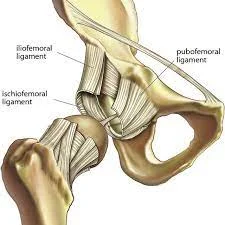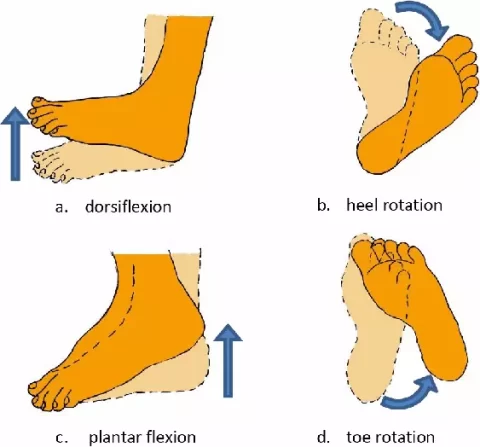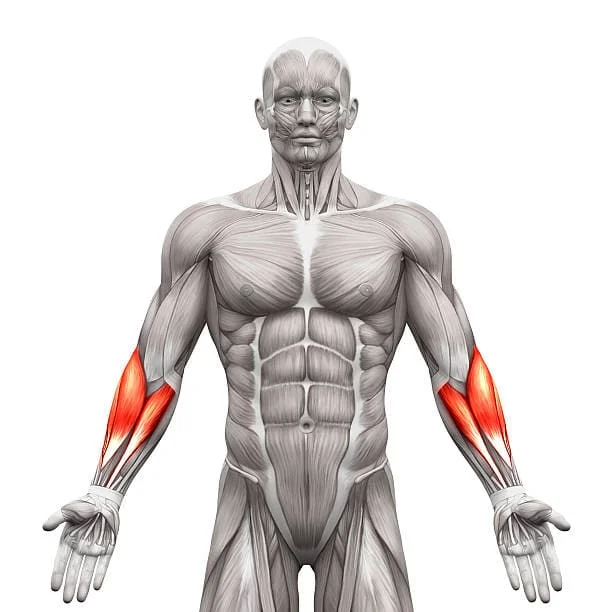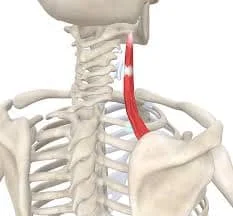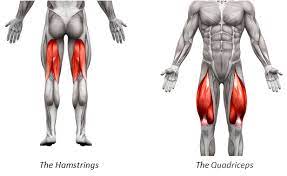Ischiofemoral Ligament
Introduction
The ischiofemoral ligament is one of the three main ligaments that stabilize the hip joint. It originates from the ischium (part of the pelvis) and attaches to the femur. This ligament helps limit internal rotation and extension of the hip, contributing to joint stability, especially during movement.
It attaches to the base of the greater trochanter, deep to the iliofemoral ligament, after spiraling superolateral to the femur’s neck and medially to the ischial portion of the acetabular rim. The ischiofemoral ligament restricts the hip joint’s medial rotation, avoids excessive extension, and protects the posterior portion of the fibrous joint capsule.
Its primary purpose is restricting the hip joint’s excessive external rotation and extension. Additionally, it helps in keeping the femoral head—the femur’s ball-shaped end—positioned inside the acetabulum, or hip joint socket. Hip pain, instability, and decreased range of motion can be caused by ischiofemoral ligament dysfunction or injury.
Structure of the ischiofemoral ligament
Collagen fibers comprise most of the dense, fibrous band of tissue known as the ischiofemoral ligament. The ligament’s strength and resistance to stretching originate from the parallel arrangement of these fibers.
The superior and inferior fibers are the two primary components of the ligament. The superior fibers attach to the greater trochanter of the femur by running laterally and obliquely downward from the ischial tuberosity. In addition to coming from the ischial tuberosity, the inferior fibers run more vertically and connect to the femur at a slightly lower angle than the superior fibers.
The ischiofemoral ligament narrows gradually as it gets closer to its insertion on the femur, having been thickest at its origin on the ischial tuberosity. Additionally, it is wider where it is inserted on the greater trochanter than where it originates.
The synovial membrane, which covers the ligament, releases synovial fluid to keep it lubricated and healthy. This lessens friction between the surrounding tissues and the ligament when the hip joint moves.
The structure of the ischiofemoral ligament generally permits it to give the hip joint stability while maintaining some degree of mobility and flexibility.
Function of the ischiofemoral ligament
The hip joint depends on the ischiofemoral ligament for several vital functions.
First, it stabilizes the joint by preventing the femur from moving too much about the pelvis. This is particularly crucial when performing activities like running or jumping that require forceful or weight-bearing motions. In the absence of the ischiofemoral ligament, the femur could dislocate or move out of its natural position, causing pain and dysfunction in the hip joint.
Second, the ligament lowers the risk of injury or harm to the surrounding tissues by assisting in the distribution of forces and stresses throughout the joint. This is especially crucial for activities like sports and manual labor that require high-impact or repetitive motions.
Thirdly, the ischiofemoral ligament helps to keep the hip joint in the right alignment. Hip pain and dysfunction may result from abnormal femur movements or positioning brought on by weakening or injury to the ligament.
In summary, the ischiofemoral ligament is a crucial component that supports and stabilizes the hip joint, enabling the best possible function and range of motion.
Blood supply of the ischiofemoral ligament
The blood supply to the ischiofemoral ligament comes from multiple sources. The medial circumflex femoral artery, which emerges from the deep femoral artery, is one of the primary sources. The ischiofemoral ligament and other nearby structures receive blood flow from this artery, which runs along the back of the hip joint.
Branches of the inferior gluteal artery and the obturator artery supply blood to the ischiofemoral ligament in addition to the medial circumflex femoral artery. These arteries give the ligament more support and contribute to its continued health and functionality.
There are various reasons why the ischiofemoral ligament’s blood supply is crucial. First of all, it keeps the ligament robust and healthy, which is crucial for preserving hip joint stability and function. In the event of ligament harm or injury, a healthy blood supply can help in the healing and recovery process. Lastly, diseases like ischemia or necrosis, which can happen when tissues don’t get enough oxygen and nutrients, can be avoided with a healthy blood supply.
Symptoms of the ischiofemoral ligament
Depending on the severity of the injury, ischiofemoral ligament injuries might present with different symptoms. However, the following are some typical symptoms:
Hip Pain: When an ischiofemoral ligament injury occurs, pain is the most typical sign. Activity may make the discomfort worse. It might be realized in the buttocks, hips, or groin.
Stiffness: A restricted range of motion brought on by the injury may result in stiffness in the hip joint.
Weakness: The inability to support weight or carry out specific actions might result in hip joint weakness.
Swelling: The inflammation brought on by the injury may result in swelling around the hip joint.
Bruising: Trauma or injury to the region may result in bruises around the hip joint.
Clicking or popping: When the hip joint is moved, injury to the ligament may cause clicking or popping sounds.
Instability: A partial or total tear of the ischiofemoral ligament may result in instability in the hip joint.
If any of these symptoms appear, it is important to get a professional medical diagnosis because injuries that go untreated can result in chronic pain and long-term problems. Physical therapy, pain management, rest, and in severe cases, surgery, are possible forms of treatment.
Injuries of the ischiofemoral ligament
A robust ring of connective tissue called the ischiofemoral ligament joins the ischium bone of the pelvis to the thigh’s femur bone. It is crucial for maintaining hip joint stability and facilitating fluid leg movement. However, the ischiofemoral ligament may sustain harm or injury as a result of severe strain from specific activities. The following activities may affect the ischiofemoral ligament:
Running: Running is a high-impact exercise that causes the hip joint to move repetitively. The ischiofemoral ligament may experience significant tension or tearing as a result of this.
Jumping: The hip joint and ischiofemoral ligament may be severely strained by jumping sports like basketball, volleyball, or gymnastics. Trauma to the ligament can also result after landing from a jump.
Twisting: Exercises like dance or martial arts that require the hip joint to be rotated or twisted can put stress on the ischiofemoral ligament.
Long-term sitting: Constant sitting can make the hip joint stiff and tight, which can put stress on the ischiofemoral ligament.
Overuse: The ischiofemoral ligament may become inflamed and injured as a result of excessive hip joint use, such as repetitive motions performed at work or during sports.
When participating in these activities, it is crucial to exercise caution by warming up properly, using the right techniques, and taking breaks when necessary. To avoid more injuries, it’s critical to seek medical attention if you feel pain or discomfort in your hip joint during or after these activities.
Treatment of the ischiofemoral ligament
Conservative treatment
Non-surgical techniques are usually used in conservative treatment of the ischiofemoral ligament to control pain and encourage healing. The following are some typical conservative therapies:
Rest: To lessen pain and inflammation, rest the affected hip joint and avoid activities that strain the ligament.
Ice and heat therapy: Several times a day, apply ice to the affected area for 20 minutes at a time to help reduce swelling and pain. Taking a warm bath or applying a heating pad are examples of heat therapy that can help relax muscles and improve blood flow to the affected region.
Physical therapy: To help increase flexibility and strengthen the muscles surrounding the hip joint, a physical therapist can create an individual exercise regimen. This may facilitate healing and lessen the strain on the ischiofemoral ligament.
Medication: Pain management and inflammation reduction can be achieved with over-the-counter pain relievers. To treat pain and inflammation, a doctor may occasionally recommend stronger drugs or corticosteroid injections.
Lifestyle modifications: Reducing weight, enhancing posture, and avoiding extended periods of sitting are some changes in lifestyle that can ease hip joint stress and encourage recovery.
Depending on how severe the injury is, conservative treatment may not show results for weeks or months. Avoiding activities that worsen the injury and following the treatment plan prescribed by your healthcare provider are crucial. Surgery might be required if conservative treatment is unable to reduce symptoms.
Physiotherapy treatment
Exercises and manual therapy methods are commonly used in physiotherapy to treat the ischiofemoral ligament to lessen pain, increase range of motion, and encourage healing. The following are some typical ischiofemoral ligament physiotherapy treatments:
Stretching exercises: To help increase hip joint flexibility and lessen the strain on the ischiofemoral ligament, a physiotherapist may suggest stretching exercises. Stretches for the hamstrings, quadriceps, and hip flexors may be among these exercises.
Strengthening exercises: Strengthening exercises can lessen the strain on the ischiofemoral ligament and increase hip joint stability. Hip abductor, hip adductor, and gluteal strengthening exercises are a few examples of these exercises.
Manual therapy: To lessen pain and increase the hip joint range of motion, a physiotherapist might use manual therapy techniques like massage, joint mobilization, and soft tissue manipulation.
Electrical stimulation: This technique may be used to enhance hip joint muscle function and lessen pain.
Ultrasound therapy: Ultrasound therapy helps the affected area heal and reduce inflammation by using high-frequency sound waves.
Bracing or taping: These techniques can be used to support the hip joint and lessen the strain that physical activity places on the ischiofemoral ligament.
Advice and education: To lessen the hip joint strain and encourage healing, a physiotherapist can offer advice and instruction on suitable body mechanics, posture, and activities to avoid or change.
Therefore, using a combination of exercises and manual therapy techniques, physiotherapy treatment for the ischiofemoral ligament aims to reduce pain, improve strength and flexibility, and promote healing. Avoiding activities that worsen the injury and following the treatment plan suggested by your physiotherapist are crucial.
Risk factors of the ischiofemoral ligament
A robust band of connective tissue called the ischiofemoral ligament joins the ischium bone of the pelvis to the thigh’s femur bone. It helps keep the femur bone from moving too much and stabilizes the hip joint. However, some things can make it more likely that the ischiofemoral ligament will get injured. Among these risk factors are:
- Overuse: The ischiofemoral ligament may sustain injury as a result of repetitive motions like running, jumping, or kicking.
- Bad posture: Bad posture can strain the ischiofemoral ligament by putting too much stress on the hip joint.
- Weak muscles: The glutes, hamstrings, and hip adductors are some of the muscles that surround the hip joint. Weakness in these muscles can put more strain on the ischiofemoral ligament.
- Tight muscles: The ischiofemoral ligament may also be under more stress if the muscles that surround the hip joint, such as the quadriceps and hip flexors, are tight.
- Prior injury: The risk of additional injury to the ischiofemoral ligament may be elevated if there is a history of prior injuries to the hip joint or the surrounding muscles and ligaments.
- Age: The risk of injury to the ischiofemoral ligament increases with age because our connective tissues become less elastic and more prone to injury.
- Genetics: Some individuals may have a genetic predisposition to specific musculoskeletal disorders, which raises their risk of ischiofemoral ligament injury.
To lower the risks of ischiofemoral ligament injury, it is crucial to consider these risk factors when performing suitable exercise, stretching, and strengthening exercises. A customized treatment plan can be created with the assistance of a physiotherapist to fix any underlying risk factors and stop additional injuries.
How to lower the ischiofemoral ligament’s risk factors
The underlying risk factors must be discussed to lower the risk of ischiofemoral ligament injury. The risk of an injury to the ischiofemoral ligament can be decreased in the following ways:
Correct training: Take part in suitable instruction regimens that incorporate a range of exercises to build stronger hip-related muscles, such as the glutes, hamstrings, and hip adductors. This will lessen the strain on the ischiofemoral ligament by distributing the load evenly across the hip joint.
Stretching: To keep the muscles around the hip joint, such as the quadriceps and hip flexors, flexible, do stretching exercises regularly. This will lessen the strain on these muscles and keep the ischiofemoral ligament from being overstressed.
Good posture: Keeping a straight posture all day, particularly when standing or sitting for extended periods. This will lessen the strain on the ischiofemoral ligament and lessen the stress on the hip joint.
Rest and recovery: To avoid overuse injuries, schedule enough time for recovery and rest in between workouts. Your body will have more time to heal and fix any injuries to the surrounding muscles or ischiofemoral ligament.
Gradual progression: To prevent sudden increases in hip joint stress, gradually increase the length and intensity of your workouts. This will lessen the risk of ischiofemoral ligament injuries and help avoid overuse injuries.
Seek expert assistance: To create a customized treatment plan that fixes any underlying risk factors and helps in preventing additional ischiofemoral ligament injury, speak with a physiotherapist or sports medicine specialist.
You can sustain the best possible hip joint health and lower your risks of suffering an ischiofemoral ligament injury by being aware of these risk factors.
FAQs
The ischiofemoral ligament: what is it?
A band of robust connective tissue called the ischiofemoral ligament serves to stabilize the hip joint by joining the ischium, a portion of the pelvis, to the femur, or thigh bone.
What signs of an injury to the ischiofemoral ligament are present?
Hip or buttock pain, stiffness, weakness, and trouble moving the hip joint are all signs of an injury to the ischiofemoral ligament.
What leads to injury to the ischiofemoral ligament?
Injuries to the ischiofemoral ligament may result from trauma, overuse, or underlying diseases like arthritis or hip dysplasia.
How can an injury to the ischiofemoral ligament be identified?
A physical examination, imaging tests like MRIs or X-rays, and occasionally diagnostic injections can all be used to diagnose an injury to the ischiofemoral ligament.
How is an injury to the ischiofemoral ligament treated?
Physical therapy, anti-inflammatory drugs, rest, ice, compression, and elevation (RICE), and in severe cases, surgery, are all possible treatments for an ischiofemoral ligament injury.
Is it possible to avoid an injury to the ischiofemoral ligament?
Incorrect training methods, muscular imbalances, and excessive use are examples of underlying risk factors that can be discussed to prevent an ischiofemoral ligament injury. Another way to reduce the risk of injury is to keep your posture correct and increase the intensity of your exercises gradually.
References
- Patel, D. (2023d, August 8). Ischiofemoral ligament – structure, function, injury. Samarpan Physiotherapy Clinic. https://samarpanphysioclinic.com/ischiofemoral-ligament/

